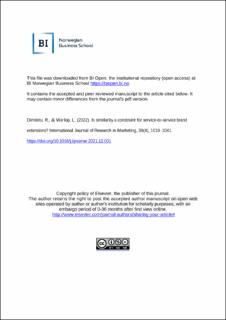| dc.contributor.author | Dimitriu, Radu | |
| dc.contributor.author | Warlop, Luk | |
| dc.date.accessioned | 2023-08-16T08:55:04Z | |
| dc.date.available | 2023-08-16T08:55:04Z | |
| dc.date.created | 2021-12-06T18:44:02Z | |
| dc.date.issued | 2021 | |
| dc.identifier.issn | 0167-8116 | |
| dc.identifier.uri | https://hdl.handle.net/11250/3084332 | |
| dc.description.abstract | Are service brands constrained in launching new service offerings? Both research evidence and managerial wisdom suggest brands should extend to similar categories. However, in five studies using real-life brands - four experiments and one large-sample survey - we provide evidence that similarity is less of a constraint for service brands extending to other service categories (service-to-service extensions), compared to cases involving parent brands or extension categories of a product nature. Importantly, we demonstrate that such an effect occurs because service brands possess associations relevant across the spectrum of service categories. Our results suggest that service brand managers have the opportunity to stretch their brands to dissimilar service offerings; yet, they need to ensure the marketing execution does not make the brands’ service associations inaccessible to consumers. The findings suggest that even product brands can build service associations by adding service components to their offering, thus becoming “servitized” and better able to extend to dissimilar service categories. Overall, our work contributes to the academic debate documenting that the principles governing the management of product vs. service brands are not identical. | en_US |
| dc.language.iso | eng | en_US |
| dc.publisher | Elsevier | en_US |
| dc.rights | Attribution-NonCommercial-NoDerivatives 4.0 Internasjonal | * |
| dc.rights.uri | http://creativecommons.org/licenses/by-nc-nd/4.0/deed.no | * |
| dc.subject | Brand extensions | en_US |
| dc.subject | Service associations | en_US |
| dc.title | Is similarity a constraint for service to service brand extensions? | en_US |
| dc.type | Journal article | en_US |
| dc.type | Peer reviewed | en_US |
| dc.description.version | acceptedVersion | en_US |
| dc.subject.nsi | VDP::Bedriftsøkonomi: 213 | en_US |
| dc.subject.nsi | VDP::Business: 213 | en_US |
| dc.source.pagenumber | 1019-1041 | en_US |
| dc.source.volume | 39 | en_US |
| dc.source.journal | International Journal of Research in Marketing | en_US |
| dc.source.issue | 4 | en_US |
| dc.identifier.doi | 10.1016/j.ijresmar.2021.12.001 | |
| dc.identifier.cristin | 1965277 | |
| cristin.ispublished | true | |
| cristin.fulltext | postprint | |
| cristin.fulltext | preprint | |
| cristin.qualitycode | 2 | |

